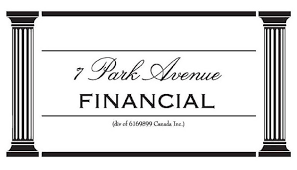|
Unlock Growth Capital: How Purchase Order Financing Bridges Your Funding Gap
Purchase Order to Profit: How Canadian Businesses Finance Large Opportunities
YOUR COMPANY IS LOOKING FOR PO FINANCING!
PURCHASE ORDER FINANCING IN CANADA WORKS!
You've arrived at the right address! Welcome to 7 Park Avenue Financial
Financing & Cash flow are the biggest issues facing businesses today
ARE YOU UNAWARE OR DISSATISFIED WITH YOUR CURRENT BUSINESS FINANCING OPTIONS?
CONTACT US
CALL NOW - DIRECT LINE - 416 319 5769 - Let's talk or arrange a meeting to discuss your needs
7 Park Avenue Financial
South Sheridan Executive Centre
2910 South Sheridan Way
Oakville, Ontario
L6J 7J8
EMAIL - sprokop@7parkavenuefinancial.com

7 Park Avenue Financial originates business financing solutions for Canadian Businesses – We offer PO Financing and other working capital financing solutions – Save time, and focus on profits and business opportunities
7 Park Avenue Financial: “Canadian Business Financing with the intelligent use of experience”
PURCHASE ORDER FUNDING
Inventory and purchase order financing in Canada is a niche, specialized area of business financing for Canadian firms that need to fulfill a customer's purchase order when funding from traditional bank financing is unavailable.
Before contemplating securing this type of financing with a purchase order financing company, we encourage you to talk to a credible business financing advisor such as 7 Park Avenue Financial with experience in these areas -
That allows you to fully understand the cost and how purchase order and inventory financing solutions might work for your company when cash flow limitations exist and you need to fulfill large customer orders to meet customer demand.
WHAT IS PURCHASE ORDER FINANCING & FUNDING
Purchase order financing, or PO Financing, is a cash advance financing solution provided by a commercial PO financing company.
These financing companies typically offer financing that allows a business to deliver their goods to a client based on the customer's creditworthiness and solid profit margins in the transaction.
Small business owners and even government contractors can fund orders in such a manner, as many small businesses can't generate enough capital to fulfill large contracts.
Instead of resorting to short-term business loans, a combination of invoice factoring and invoice financing funds the purchase order. Purchase order financing rates are higher, but they allow small businesses to accept and fulfill large orders and grow their business and operations.
Financing can be for part of an order or the complete order. When a customer pays, the business receives its money after the PO Finance company deducts its fees.
Businesses that utilize Purchase Order Finance can take on additional large orders and contracts that otherwise might not be able to be fulfilled. A successful initial transaction can lead to a long-term financing relationship.
From Order to Fulfillment: Bridging the Cash Gap
Problem: Your business has landed a significant order but lacks the capital to purchase inventory or raw materials needed for fulfillment. Without immediate funding, you risk losing the order, damaging client relationships, and missing growth opportunities.
The Solution: Let the 7 Park Avenue Financial team show you how Purchase Order Financing Lenders provide immediate funding based on your purchase orders. This allows you to fulfill large orders, maintain customer satisfaction, and grow your business without straining your cash flow.
THREE UNCOMMON TAKES ON PO FINANCING LENDERS
- Purchase order financing can be strategically deployed as a competitive advantage, allowing smaller Canadian businesses to bid confidently on contracts typically dominated by larger competitors.
- Unlike traditional lending that focuses on past performance, purchase order financing evaluates the creditworthiness of your customers, making it accessible to businesses with limited credit history but strong client relationships.
- The strategic combination of purchase order financing with other financial tools like invoice factoring creates a comprehensive cash flow solution that covers the entire order-to-payment cycle.
WHY DO COMPANIES NEED INVENTORY AND P O FINANCING SOLUTIONS
The need for inventory and PO Financing in Canada generally arises from two areas of demand for clients: they are growing too quickly and have secured new orders and contracts that they need to finance, while their financial statements might not support the level of financing required.
Banks do not offer P-O financing.
In PO funding, funds are utilized to pay your supplier costs that are part of your purchase order from clients. You receive immediate cash to fund your customer's order. Your vendor/supplier receives payment for materials and products related to your PO.
Secondly, since inventory is a key component of many firms' current assets, Canadian business owners have traditionally found it challenging to finance inventory through traditional institutions such as our Canadian chartered banks.
In most companies in Canada, all working capital revolves around inventory and receivables turnover. Depending on your industry and product, the inventory line on your balance sheet can be very significant to your total working capital.
If your firm turns over inventory, say, for example, in 60 days but finds you need to now keep 90 days of inventory on hand, your cash needs are, therefore, growing. Those needs are the new equivalent of another 30 days of sales.
HOW TO CALCULATE INVENTORY TURNOVER
Most companies know how to calculate their investment in inventory – it’s a simple calculation you should probably be monitored monthly.
The calculation is as follows:
Average inventory/average daily sales = days of sales in inventory
It’s that simple a calculation.
You might have to consider alternative inventory financing outside your banking or regular arrangements in Canada. This is a form of asset-based lending, with inventory, of course, as our focus on your financing options.
It is also important to know how accounts receivable days sales outstanding affect your cash flow and how DSO is related to overall working capital.
WHAT AMOUNT OF FINANCING CAN YOUR COMPANY OBTAIN FOR INVENTORY
How much finance can you get for your inventory?
You probably know the answer already, which is, of course, ‘it depends! ' Depending on the quality of your inventory and its turnover, you should be able to receive anywhere from 40-60% in our experience. The greater the commodity value of your inventory, the greater the financing you will get.
WHAT ARE THE REQUIREMENTS FOR A PO FINANCE FUNDING?
Businesses looking to fund purchase orders should be prepared to submit copies of the purchase order, supplier information, a breakdown of supplier requirements, and a standard business application form that might require financial statements, business history, owner information, etc.
HOW MUCH DOES PURCHASE ORDER FINANCING COST?
PO Financing continues to be another unique challenge for growing or, many times, smaller firms in Canada.
It’s a vicious cycle the Canadian business owner or financial manager is very familiar with—their suppliers want payment upfront, your customer won’t pay you in 30-60 days, and you’re caught in the middle of the manufacturing or delivery dilemma.
Banks traditionally cannot assist you with this need, as they will tend to focus on traditional borrowing criteria.
Borrowers should note that a company should have a good gross margin to support the costs of PO Finance.
However, the purchase order financier will pay suppliers on your behalf, take collateral on the inventory, and monetize that inventory into cash when you create your receivable and shop goods.
Purchase order financing is expensive, generally in the 2-3% range per month, so you should view this as a reduction in your gross margins. However, if you have good gross margins, you can significantly benefit from P.O. Financing.
Case Study: Leveraging Purchase Order Financing for Growth
When a Montreal-based electronics distributor received its most significant order ever—a $1.2 million contract from a provincial government agency—it faced an immediate challenge. Although its suppliers required a 50% upfront payment, the company had only $250,000 in available working capital.
Rather than decline the opportunity or dilute ownership through equity investment, the firm partnered with a specialized Purchase Order Financing Lender. Within five business days, the lender verified the government purchase order and advanced 100% of the required supplier payment directly to its manufacturers.
CONCLUSION - PURCHASE ORDER FINANCING COMPANIES
In summary, inventory and purchase order financing is needed by many Canadian firms that cannot otherwise finance their business traditionally.
They can also be combined in alternative lenders' business line of credit facilities.
These two types of financings are specialized and should be entered into with a proper level of analysis of costs and benefits via the financing process. The purchase order financing transaction can be complex, so talk to an expert.
Stop turning down large orders due to cash constraints – discover how Purchase Order Financing Lenders can fund your success while your customers' credit does the heavy lifting.
Call 7 Park Avenue Financial, a trusted, credible, and experienced advisor in alternative financing in Canada, to determine if these business funding strategies are right for you.
FAQ: FREQUENTLY ASKED QUESTIONS / PEOPLE ALSO ASK/ MORE INFORMATION
What is the best way to finance inventory?
Inventory requirements that are short term in nature are typically financed best via a business credit line which allows funds to be used to draw on inventory purchase needs as required.
Can you get a loan with a purchase order?
PO financing solutions are not debt per se and do not bring additional term debt to a company's balance sheet. The ability of a P O financing company to pay a vendor on a firm's behalf allows the business to, in effect, monetize their purchase order and fulfill client orders. The PO funding solution allows a company to take on larger orders and contracts and the PO Financing company deducts their fees from the remaining balance only when the order is paid.
Who Uses Purchase Order Financing?
Many businesses qualify and can use PO financing - Firms such as distributors and resellers/wholesalers can benefit from inventory and PO financing.
Many industries have seasonality attached to orders. P O Funding is a type of ' bulge financing ' that allows businesses to smooth out cash flow and working capital needs as they deliver the goods to clients on orders and contracts. Firms that do not have all the access they need to traditional credit and banking can benefit substantially from this method of business financing.
How does purchase order financing differ from a traditional business loan?
Purchase order financing is transaction-based funding secured by specific customer orders, not a loan against your business assets. Lenders advance funds directly to your suppliers based on confirmed purchase orders from creditworthy customers.
What types of businesses qualify for purchase order financing?
Businesses that resell finished goods, assemble products from components, or manufacture custom products for B2B or government customers with strong credit typically qualify. This includes distributors, wholesalers, manufacturers, and government contractors in Canada.
What percentage of my purchase order value can I receive from purchase order financing?
Most Purchasing order Lenders provide 70-100% of the supplier costs needed to fulfill your order. The advance amount depends on your supplier's terms, customer creditworthiness, and product specifications.
How quickly can I receive funding from purchase order financing?
Once approved, Purchase Order Financing Lenders typically provide funding within 3-10 business days, enabling you to pay suppliers promptly and meet delivery timelines.
What documentation is required for purchase order financing?
You'll need to provide confirmed purchase orders, supplier or proforma invoices, your company's financial statements, and information about your customer's creditworthiness.
How do Purchase Order Financing Lenders enable business growth?
Purchase order financing provides the working capital needed to accept larger orders that would otherwise be beyond your financial capacity, allowing your business to scale operations and increase revenue without taking on traditional debt.
What advantages does purchase order funding offer over traditional bank loans?
Purchase order funding approval is based primarily on your customers' creditworthiness rather than your business credit history, making it accessible to younger companies and those with limited credit. Additionally, funding is provided quickly—typically within days rather than weeks or months for bank loans.
Can purchase order financing help businesses with seasonal demands?
Purchase order financing is ideal for businesses with seasonal fluctuations as it scales with order volume. It provides more funding during peak seasons without creating debt obligations during slower periods. This flexibility helps maintain healthy cash flow throughout the year.
How does purchase order funding impact supplier relationships?
By ensuring prompt payment to suppliers through purchase order financing, businesses build stronger supplier relationships, often qualifying for early payment discounts, better terms, and priority fulfillment status—creating competitive advantages in the market.
Is purchase order financing suitable for international trade?
Purchase order financing is particularly valuable for international trade. It addresses the challenges of cross-border transactions, including upfront supplier payments, longer shipping times, and extended customer payment terms, enabling Canadian businesses to expand globally with reduced financial risk.
How does purchase order financing differ from inventory financing?
- Purchase order financing provides funding specifically for confirmed customer orders before production or sourcing.
- Inventory financing provides funding against existing inventory already produced or acquired.
- Purchase order financing focuses on your customer's creditworthiness, while inventory financing looks at the value of your stock
- PO financing is transaction-specific, while inventory financing can be used more flexibly.
What industries benefit most from purchase order financing?
- Manufacturing companies with significant raw material or component costs
- Importers and distributors with international suppliers require upfront payment
- Government contractors facing long payment cycles but substantial order values
- Seasonal businesses needing to scale production capacity temporarily
- Technology hardware providers with high cost of goods sold
What documents and qualifications do Purchase Order Financing Lenders require?
- Confirmed purchase orders from creditworthy customers
- Detailed supplier quotes or invoices showing costs to fulfill orders
- Business registration and ownership documentation
- Profit and loss statements and balance sheets (typically last 6-12 months)
- Clear production or distribution plan showing fulfillment capability
- Proof of good standing with suppliers and relevant licensing
What are 10 Specific Use Cases for Purchase Order Financing From PO Lenders
-
A Canadian electronics distributor receives a $500,000 order from a provincial government but lacks capital to pay their overseas suppliers who require 50% upfront.
-
A Montreal-based furniture manufacturer lands a contract with a national hotel chain but needs to purchase raw materials worth $300,000 to begin production.
-
A Vancouver apparel company secures a seasonal order from a major retailer that exceeds their normal monthly production capacity by 300%.
-
An Alberta-based oil equipment supplier receives an unexpected opportunity to fulfill an urgent order for specialized parts but lacks immediate funds for materials.
-
A Toronto food products distributor wins a contract with a grocery chain requiring $250,000 in inventory purchases but faces a 60-day payment term from the customer.
-
A medical supply company in Quebec receives a large government contract but needs to import components from multiple international suppliers requiring advance payment.
-
An Ottawa-based technology hardware provider needs to purchase $400,000 in components to fulfill a corporate client order with net-60 payment terms.
-
A seasonal holiday decoration manufacturer needs to begin production six months before receiving payment from retailers.
-
A Halifax-based industrial equipment distributor wins a contract requiring specialized inventory purchases from Germany with 100% prepayment requirements.
-
A Winnipeg clothing manufacturer receives their largest-ever order from a national retailer but lacks the working capital to purchase fabric and hire additional temporary staff for production.
Statistics on Purchase Order Financing
- According to the Asset-Based Finance Association, purchase order financing has grown by approximately 12% annually in North America over the past five years.
- Canadian Federation of Independent Business reports that 41% of small and medium-sized businesses cite cash flow as their biggest challenge when fulfilling large orders.
- Industry data suggests that businesses using purchase order financing typically experience a 30-40% increase in order capacity within the first year.
- The Trade Finance Global 2023 report indicates that Canada's average purchase order financing transaction ranges from $50,000 to $1 million.
- Nearly 60% of Canadian wholesalers and distributors have used purchase orders or trade financing to manage international supply chains.
- Research from Deloitte shows that businesses using purchase order financing report 22% higher customer retention rates due to improved ability to fulfill orders on time.
Citations / More Information
- Canadian Lenders Association. (2023). "Alternative Financing Growth Report: Purchase Order Financing Trends in Canada." https://www.canadianlenders.org
- Deloitte Canada. (2022). "Supply Chain Financing Solutions for Canadian SMEs." https://www2.deloitte.com/ca/en.html
- Export Development Canada. (2023). "Trade Finance Solutions for Canadian Exporters." https://www.edc.ca
- Business Development Bank of Canada. (2023). "Working Capital Solutions for Growing Businesses." https://www.bdc.ca
- PwC Canada. (2022). "Alternative Financing Landscape: Purchase Order and Supply Chain Finance." https://www.pwc.com/ca/en.html

' Canadian Business Financing With The Intelligent Use Of Experience '
STAN PROKOP
7 Park Avenue Financial/Copyright/2025

Stan Prokop is the founder of 7 Park Avenue Financial and a recognized expert on Canadian Business Financing. Since 2004 Stan has helped hundreds of small, medium and large organizations achieve the financing they need to survive and grow. He has decades of credit and lending experience working for firms such as Hewlett Packard / Cable & Wireless / Ashland Oil
|